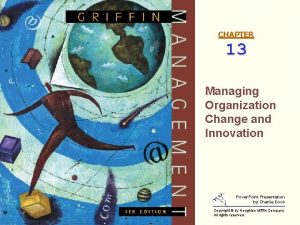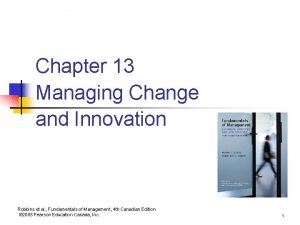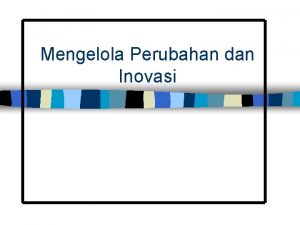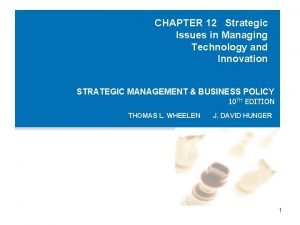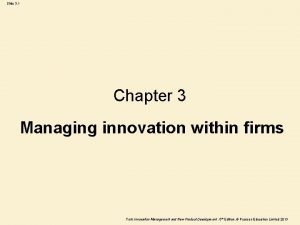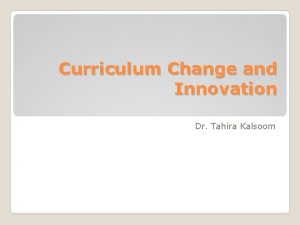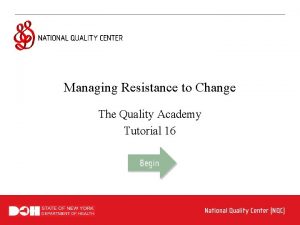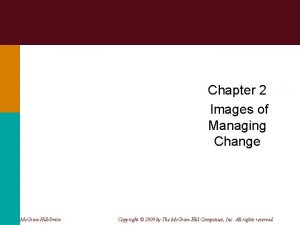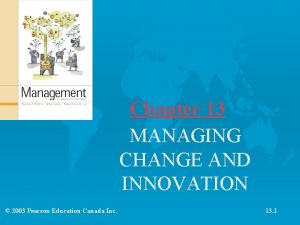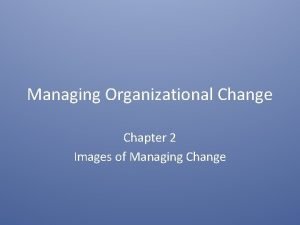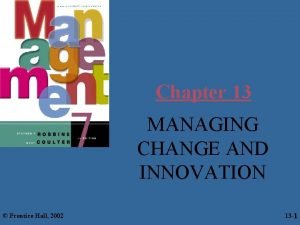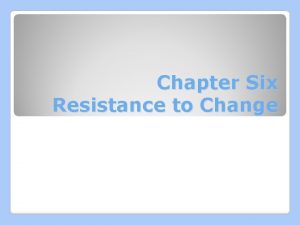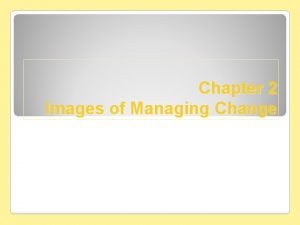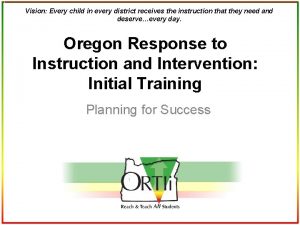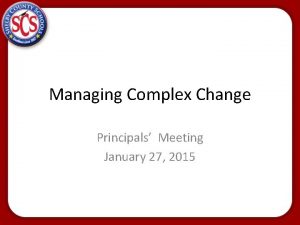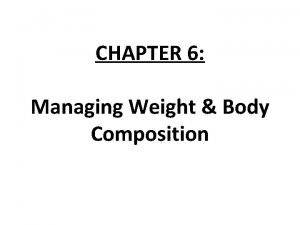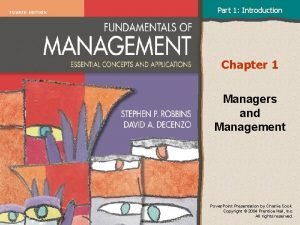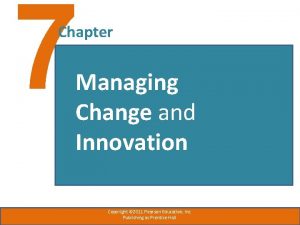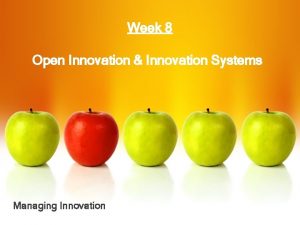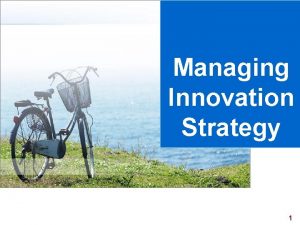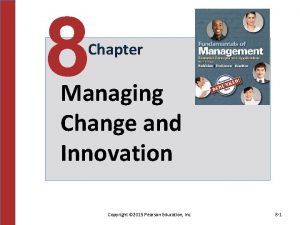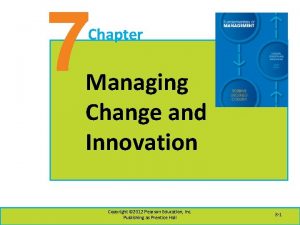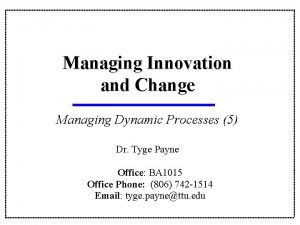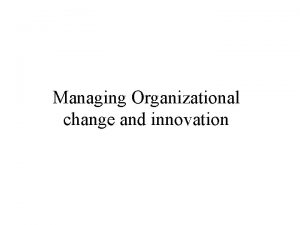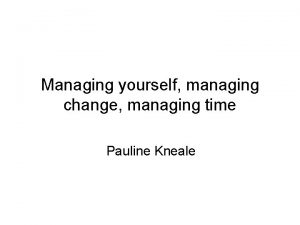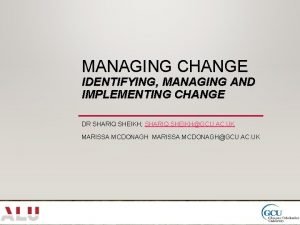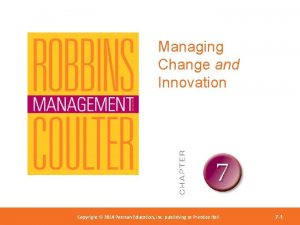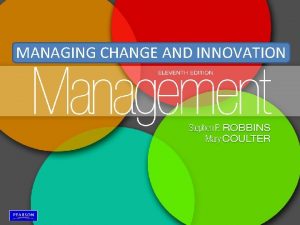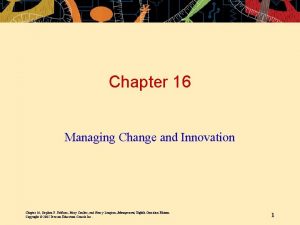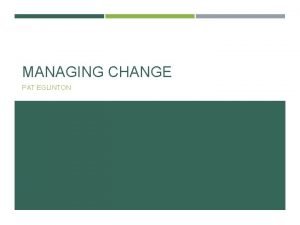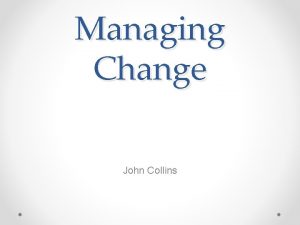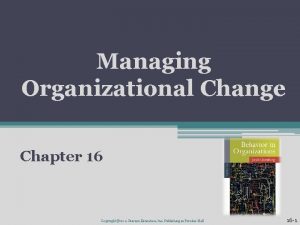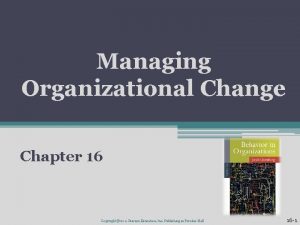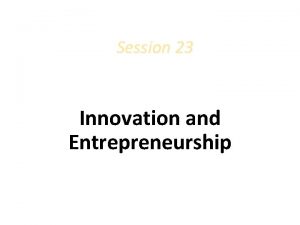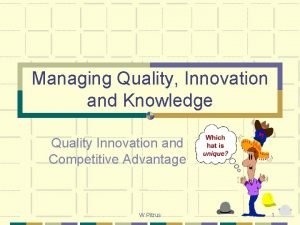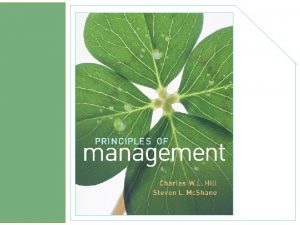8 Chapter Managing Change and Innovation Copyright 2011
































- Slides: 32

8 Chapter Managing Change and Innovation Copyright © 2011 Pearson Education, Inc. Publishing as Prentice Hall.

Learning Outcomes • Define organizational change and compare and contrast views on the change process • Explain how to manage resistance to change • Describe what managers need to know about employee stress • Discuss techniques for stimulating innovation Copyright © 2011 Pearson Education, Inc. Publishing as Prentice Hall. 7 -2

What Is Change and How Do Managers Deal with It? • Organizational Change – Any alteration of an organization’s people, structure, or technology Copyright © 2011 Pearson Education, Inc. Publishing as Prentice Hall. 7 -3

Copyright © 2011 Pearson Education, Inc. Publishing as Prentice Hall. 7 -4

WHAT EXTERNAL FORCES CREATE A NEED TO CHANGE? • The external forces that create the need for organizational change come from various sources: – Marketplace – Technology – Government laws and regulations – Economy – Labor markets Copyright © 2011 Pearson Education, Inc. Publishing as Prentice Hall. 7 -5

Copyright © 2011 Pearson Education, Inc. Publishing as Prentice Hall. 7 -6

How Do Organizations Implement Planned Changes? • Organization Development (OD) – Efforts that assist organizational members with a planned change by focusing on their attitudes and values – Popular OD efforts in organizations rely heavily on group interactions and cooperation Copyright © 2011 Pearson Education, Inc. Publishing as Prentice Hall. 7 -7

Organizational Development Activities • Survey feedback – A method of assessing employees’ attitudes toward and perceptions of a change • Process Consultation – Using outside consultants to assess organizational processes such as workflow, informal intra-unit relationships, and formal communication channels Copyright © 2011 Pearson Education, Inc. Publishing as Prentice Hall. 7 -8

OD Activities (cont. ) • Team-Building – Using activities to help work groups set goals, develop positive interpersonal relationships, and clarify the roles and responsibilities of each team member • Intergroup Development – Activities that attempt to make several work groups more cohesive Copyright © 2011 Pearson Education, Inc. Publishing as Prentice Hall. 7 -9

Why Do People Resist Organizational Change? Why do people resist organizational change? – Change replaces the known with uncertainty – We do things out of habit – Fear of losing something already possessed What are the techniques for reducing resistance to change? Copyright © 2011 Pearson Education, Inc. Publishing as Prentice Hall. 7 -10

Copyright © 2011 Pearson Education, Inc. Publishing as Prentice Hall. 7 -11

What Is Stress? • Stress – The adverse reaction people have to excessive pressure placed on them from extraordinary demands, constraints, or opportunities. Copyright © 2011 Pearson Education, Inc. Publishing as Prentice Hall. 7 -12

What Causes Stress? • Stressors – Factors that cause stress • Karoshi – A Japanese term that refers to a sudden death caused by overworking • Role Conflicts – Work expectations that are hard to satisfy Copyright © 2011 Pearson Education, Inc. Publishing as Prentice Hall. 7 -13

Stressors (cont. ) • Role Overload – Having more work to accomplish than time permits • Role Ambiguity – When role expectations are not clearly understood Copyright © 2011 Pearson Education, Inc. Publishing as Prentice Hall. 7 -14

Personal Factors • Type A Personality – People who have a chronic sense of urgency and an excessive competitive drive • Type B Personality – People who are relaxed and easygoing and accept change easily Copyright © 2011 Pearson Education, Inc. Publishing as Prentice Hall. 7 -15

Copyright © 2011 Pearson Education, Inc. Publishing as Prentice Hall. 7 -16

Sources of Stress Personal Life Job Responsibilities Membership in Groups Work-Life Balance Environmental Uncertainty 7 -17

Personal Sources of Stress • Major Life Events – Death of a loved one – Divorce – Serious illness – Getting arrested – Getting married – Buying a house – Having a baby • Minor Life Events – Getting a speeding ticket – Have trouble with your in-laws – Getting caught in traffic – Going on vacation – Getting a new assignment at work 7 -18

Job-Related Stressors • • • Role conflict Role ambiguity Overload Underload Challenging assignments Economic well-being and job security 7 -19

Group and Organization-Related Stressors • • Cultural differences Uncomfortable working conditions Unsafe working conditions Mergers and acquisitions 7 -20

Work-Life Balance • Elder care • Child care • Value conflict

Environmental Uncertainty • • • Global instability Aftermath of war and terrorism SARS Corporate scandals Exposure to toxins 7 -22

Coping Strategies for Individuals • Problem-focused – Time Management – Mentoring – Role Negotiation • Emotion-focused – Exercise – Meditation – Social Support – Clinical Counseling 7 -23

Time-Management Steps • Make lists of all tasks to accomplish during day • Prioritize tasks • Estimate length of time required to complete each task 7 -24

Nonfunctional Coping Strategies • • Entertaining/ Relaxing Eating Drinking Taking drugs 7 -25

How Can Stress Be Reduced? • Employee Assistance Programs (EAPs) – Programs offered by organizations to help employees overcome personal and health related problems • Wellness Programs – Programs offered by organizations to help employees prevent health problems Copyright © 2011 Pearson Education, Inc. Publishing as Prentice Hall. 7 -26

Coping Strategies for Organizations Problem-focused • Job redesign • Job rotation • Uncertainty reduction • Job security • Company day care • Flextime/job sharing • Telecommuting Emotion-focused • On-site exercise facilities • Organizational support • Employee assistance programs • Personal days/ Sabbaticals 7 -27

How Can Managers Encourage Innovation? • Creativity – The ability to combine ideas in a unique way or to make unusual associations between ideas • Innovation – The process of taking a creative idea and turning it into a useful product, service, or method of operation. – How to stimulate innovation (What are Innovation variables)? Copyright © 2011 Pearson Education, Inc. Publishing as Prentice Hall. 7 -28

Copyright © 2011 Pearson Education, Inc. Publishing as Prentice Hall. 7 -29

Fostering Innovation • Idea Champions – Individuals who actively and enthusiastically support new ideas, build support for, overcome resistance to, and ensure that innovations are implemented Copyright © 2011 Pearson Education, Inc. Publishing as Prentice Hall. 7 -30

Practice: Stress & Innovation • Make a script for a 5 -min-play about stress and how to deal with stress. • Assessment: - Creativity: 50 p - Acting skills: 50 p - Logic: 50 p - Ways to deal with stress: 50 p - Total: 200 p Copyright © 2011 Pearson Education, Inc. Publishing as Prentice Hall. 7 -31

Copyright © 2011 Pearson Education, Inc. Publishing as Prentice Hall. 7 -32
 Managing change and innovation
Managing change and innovation White-water rapids metaphor
White-water rapids metaphor Mengelola perubahan dan inovasi
Mengelola perubahan dan inovasi Strategic issues in managing technology and innovation
Strategic issues in managing technology and innovation Mysite.socccd
Mysite.socccd Disruptive and radical innovation
Disruptive and radical innovation Pearson's uncertainty map
Pearson's uncertainty map Sources of curriculum change and innovation
Sources of curriculum change and innovation Change and stress management
Change and stress management Managing complex change
Managing complex change 6 images of change management
6 images of change management Contemporary issues in managing change
Contemporary issues in managing change Organizational change management images
Organizational change management images Contemporary issues in managing change
Contemporary issues in managing change Six images of managing change
Six images of managing change Managing change images
Managing change images Managing complex change matrix
Managing complex change matrix Ambrose managing complex change
Ambrose managing complex change Physical changes of matter
Physical changes of matter Absolute change and relative change formula
Absolute change and relative change formula Whats the difference between physical and chemical change
Whats the difference between physical and chemical change Supply and demand curve shifts
Supply and demand curve shifts What is an example of chemical and physical change
What is an example of chemical and physical change Rocks change due to temperature and pressure change
Rocks change due to temperature and pressure change Whats a chemical change
Whats a chemical change First-order change
First-order change Chapter 8 managing stress and anxiety
Chapter 8 managing stress and anxiety Chapter 4 managing stress and coping with loss notes
Chapter 4 managing stress and coping with loss notes Chapter 6 managing weight and body composition
Chapter 6 managing weight and body composition Chapter 11 managing weight and eating behaviors
Chapter 11 managing weight and eating behaviors Chapter 11 managing weight and eating behaviors
Chapter 11 managing weight and eating behaviors Management chapter 1
Management chapter 1 Chapter 11 managing weight and eating behaviors
Chapter 11 managing weight and eating behaviors
